Effectiveness of HRM Practices at Sainsbury: A Detailed Report
VerifiedAdded on 2020/12/09
|10
|3994
|309
Report
AI Summary
This report provides a detailed analysis of Human Resource Management (HRM) practices, focusing on their function, purpose, and effectiveness within Sainsbury's. The report examines key HRM areas, including recruitment, selection, training and development, and employee relations. It explores the strengths and weaknesses of different recruitment methods, the benefits of various HRM practices for both employees and employers, and the significance of employee relations. Furthermore, the report delves into the impact of employment legislation on HRM decision-making and the application of different HRM practices to enhance organizational productivity. The report highlights Sainsbury's approach to HRM, emphasizing the importance of skilled HR managers, employee orientation, and creating a positive working environment. The analysis covers various functions of HRM, such as orientation, maintaining good working conditions, managing employee relations, and providing training and development opportunities. The report also discusses the impact of HRM on organizational performance and the importance of aligning HRM practices with business objectives to drive success and growth.
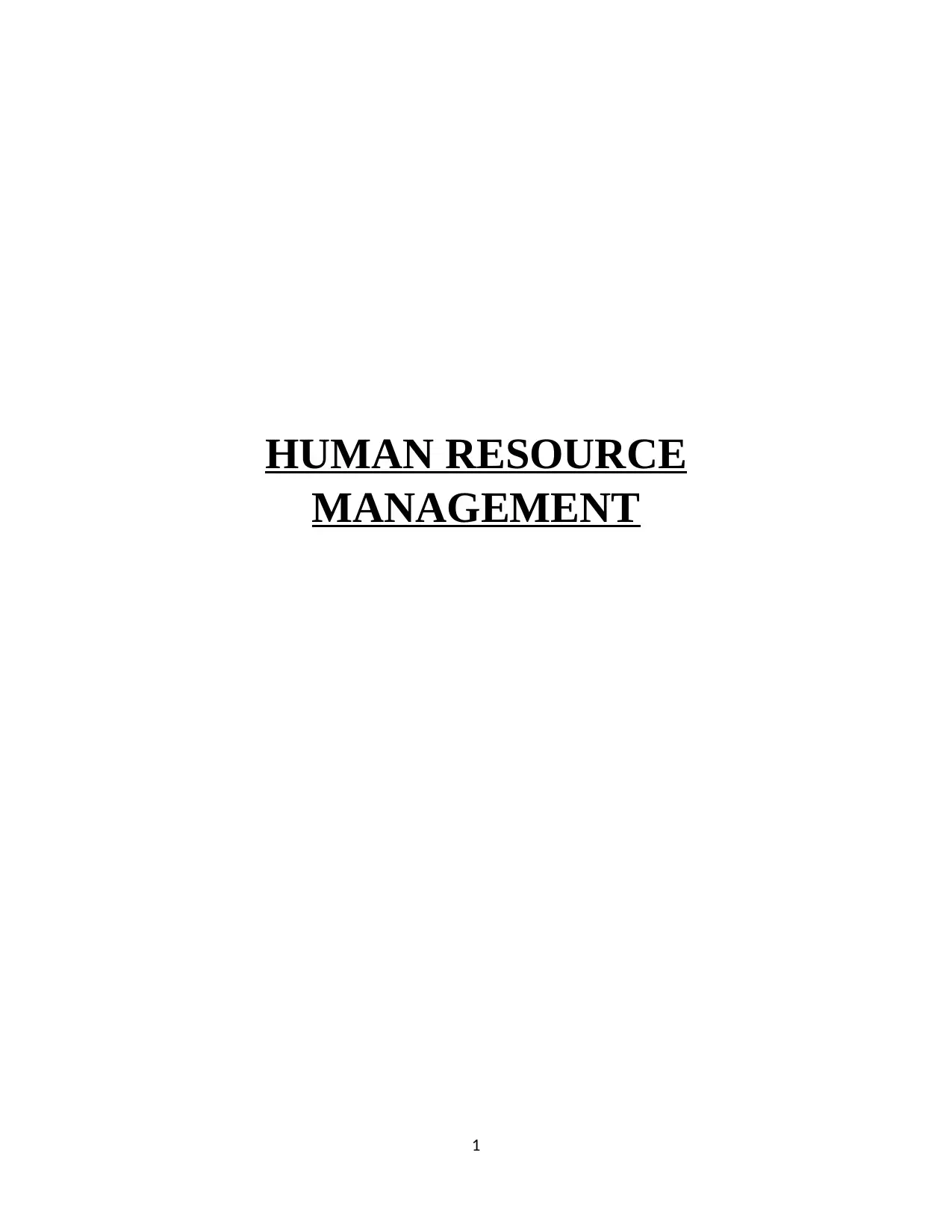
HUMAN RESOURCE
MANAGEMENT
1
MANAGEMENT
1
Paraphrase This Document
Need a fresh take? Get an instant paraphrase of this document with our AI Paraphraser
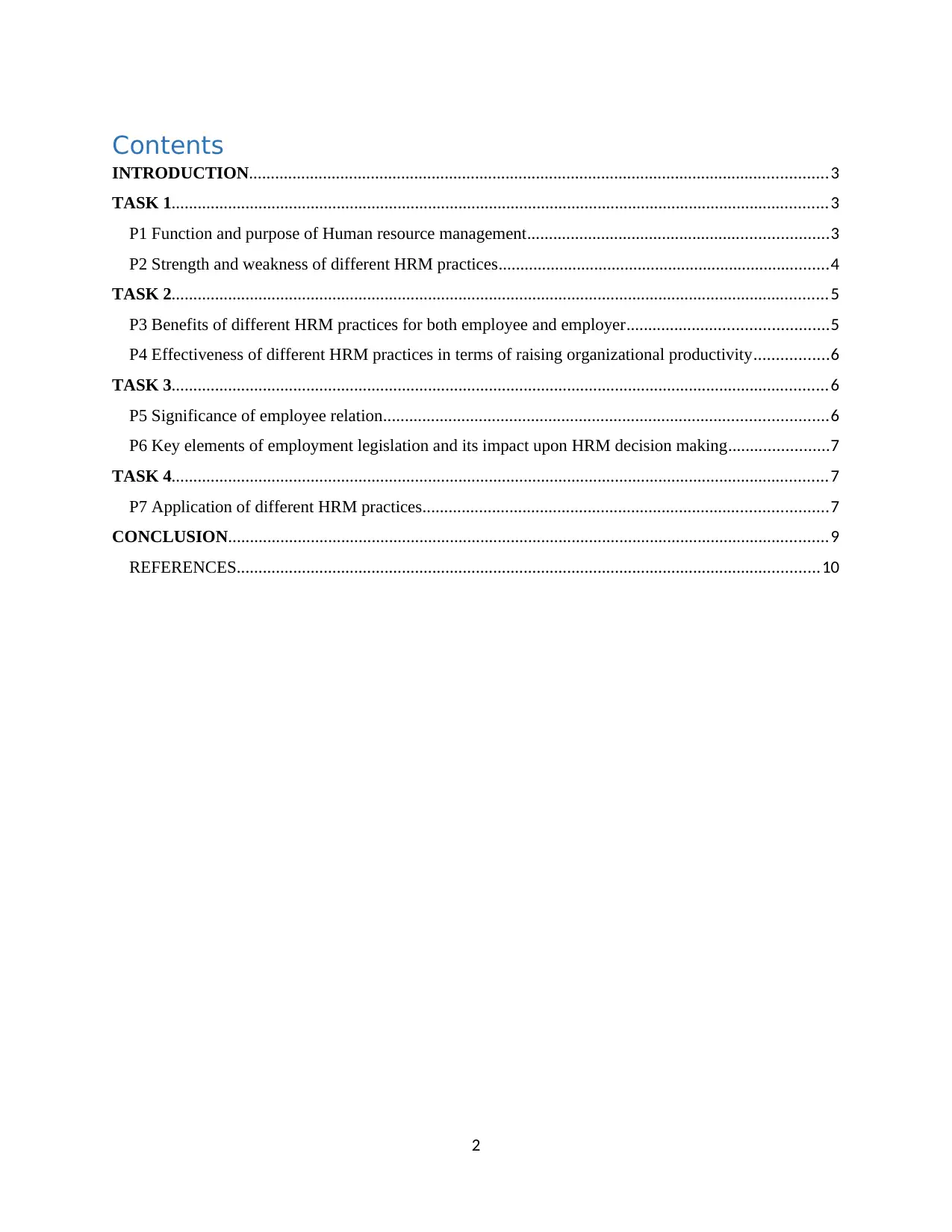
Contents
INTRODUCTION.....................................................................................................................................3
TASK 1.......................................................................................................................................................3
P1 Function and purpose of Human resource management.....................................................................3
P2 Strength and weakness of different HRM practices............................................................................4
TASK 2.......................................................................................................................................................5
P3 Benefits of different HRM practices for both employee and employer..............................................5
P4 Effectiveness of different HRM practices in terms of raising organizational productivity.................6
TASK 3.......................................................................................................................................................6
P5 Significance of employee relation......................................................................................................6
P6 Key elements of employment legislation and its impact upon HRM decision making.......................7
TASK 4.......................................................................................................................................................7
P7 Application of different HRM practices.............................................................................................7
CONCLUSION..........................................................................................................................................9
REFERENCES......................................................................................................................................10
2
INTRODUCTION.....................................................................................................................................3
TASK 1.......................................................................................................................................................3
P1 Function and purpose of Human resource management.....................................................................3
P2 Strength and weakness of different HRM practices............................................................................4
TASK 2.......................................................................................................................................................5
P3 Benefits of different HRM practices for both employee and employer..............................................5
P4 Effectiveness of different HRM practices in terms of raising organizational productivity.................6
TASK 3.......................................................................................................................................................6
P5 Significance of employee relation......................................................................................................6
P6 Key elements of employment legislation and its impact upon HRM decision making.......................7
TASK 4.......................................................................................................................................................7
P7 Application of different HRM practices.............................................................................................7
CONCLUSION..........................................................................................................................................9
REFERENCES......................................................................................................................................10
2
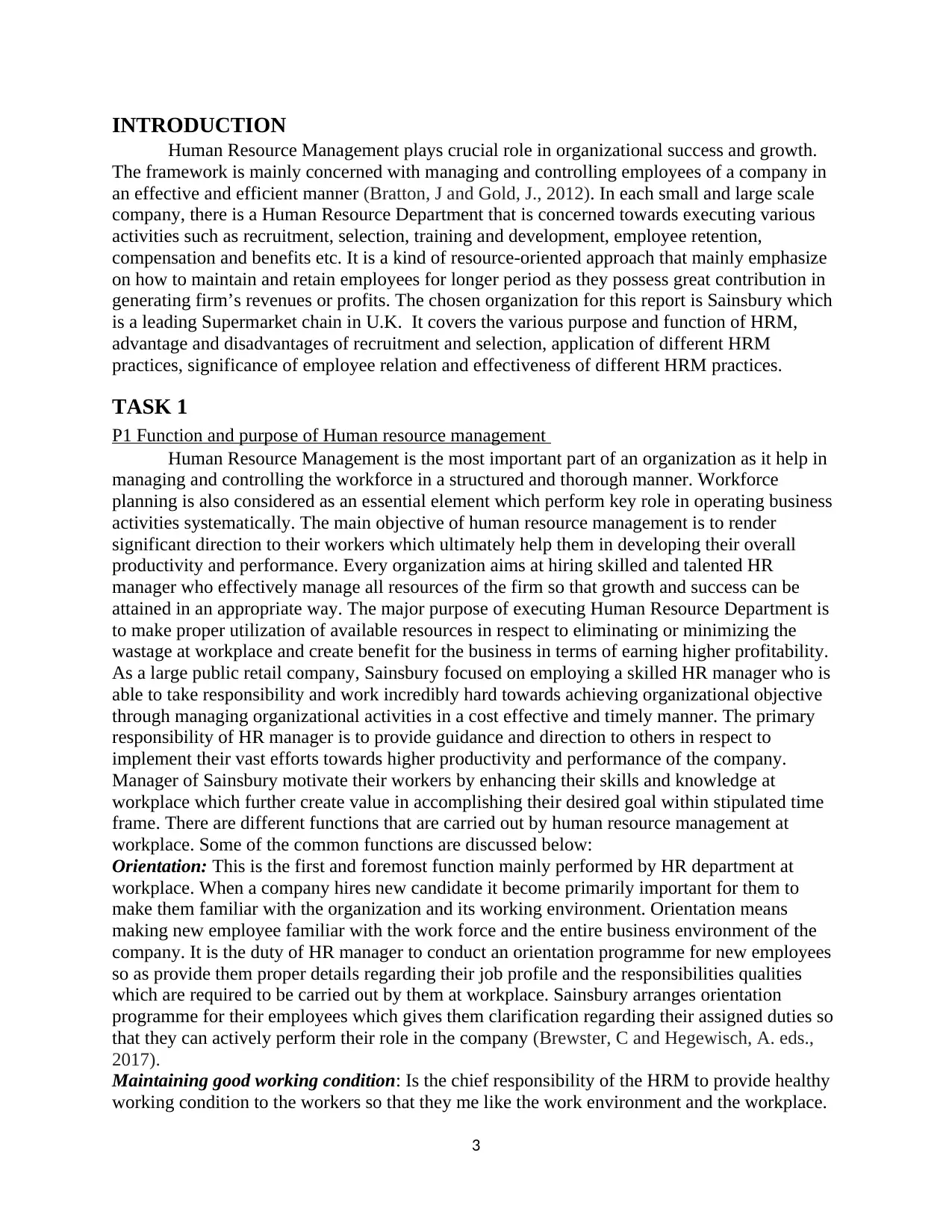
INTRODUCTION
Human Resource Management plays crucial role in organizational success and growth.
The framework is mainly concerned with managing and controlling employees of a company in
an effective and efficient manner (Bratton, J and Gold, J., 2012). In each small and large scale
company, there is a Human Resource Department that is concerned towards executing various
activities such as recruitment, selection, training and development, employee retention,
compensation and benefits etc. It is a kind of resource-oriented approach that mainly emphasize
on how to maintain and retain employees for longer period as they possess great contribution in
generating firm’s revenues or profits. The chosen organization for this report is Sainsbury which
is a leading Supermarket chain in U.K. It covers the various purpose and function of HRM,
advantage and disadvantages of recruitment and selection, application of different HRM
practices, significance of employee relation and effectiveness of different HRM practices.
TASK 1
P1 Function and purpose of Human resource management
Human Resource Management is the most important part of an organization as it help in
managing and controlling the workforce in a structured and thorough manner. Workforce
planning is also considered as an essential element which perform key role in operating business
activities systematically. The main objective of human resource management is to render
significant direction to their workers which ultimately help them in developing their overall
productivity and performance. Every organization aims at hiring skilled and talented HR
manager who effectively manage all resources of the firm so that growth and success can be
attained in an appropriate way. The major purpose of executing Human Resource Department is
to make proper utilization of available resources in respect to eliminating or minimizing the
wastage at workplace and create benefit for the business in terms of earning higher profitability.
As a large public retail company, Sainsbury focused on employing a skilled HR manager who is
able to take responsibility and work incredibly hard towards achieving organizational objective
through managing organizational activities in a cost effective and timely manner. The primary
responsibility of HR manager is to provide guidance and direction to others in respect to
implement their vast efforts towards higher productivity and performance of the company.
Manager of Sainsbury motivate their workers by enhancing their skills and knowledge at
workplace which further create value in accomplishing their desired goal within stipulated time
frame. There are different functions that are carried out by human resource management at
workplace. Some of the common functions are discussed below:
Orientation: This is the first and foremost function mainly performed by HR department at
workplace. When a company hires new candidate it become primarily important for them to
make them familiar with the organization and its working environment. Orientation means
making new employee familiar with the work force and the entire business environment of the
company. It is the duty of HR manager to conduct an orientation programme for new employees
so as provide them proper details regarding their job profile and the responsibilities qualities
which are required to be carried out by them at workplace. Sainsbury arranges orientation
programme for their employees which gives them clarification regarding their assigned duties so
that they can actively perform their role in the company (Brewster, C and Hegewisch, A. eds.,
2017).
Maintaining good working condition: Is the chief responsibility of the HRM to provide healthy
working condition to the workers so that they me like the work environment and the workplace.
3
Human Resource Management plays crucial role in organizational success and growth.
The framework is mainly concerned with managing and controlling employees of a company in
an effective and efficient manner (Bratton, J and Gold, J., 2012). In each small and large scale
company, there is a Human Resource Department that is concerned towards executing various
activities such as recruitment, selection, training and development, employee retention,
compensation and benefits etc. It is a kind of resource-oriented approach that mainly emphasize
on how to maintain and retain employees for longer period as they possess great contribution in
generating firm’s revenues or profits. The chosen organization for this report is Sainsbury which
is a leading Supermarket chain in U.K. It covers the various purpose and function of HRM,
advantage and disadvantages of recruitment and selection, application of different HRM
practices, significance of employee relation and effectiveness of different HRM practices.
TASK 1
P1 Function and purpose of Human resource management
Human Resource Management is the most important part of an organization as it help in
managing and controlling the workforce in a structured and thorough manner. Workforce
planning is also considered as an essential element which perform key role in operating business
activities systematically. The main objective of human resource management is to render
significant direction to their workers which ultimately help them in developing their overall
productivity and performance. Every organization aims at hiring skilled and talented HR
manager who effectively manage all resources of the firm so that growth and success can be
attained in an appropriate way. The major purpose of executing Human Resource Department is
to make proper utilization of available resources in respect to eliminating or minimizing the
wastage at workplace and create benefit for the business in terms of earning higher profitability.
As a large public retail company, Sainsbury focused on employing a skilled HR manager who is
able to take responsibility and work incredibly hard towards achieving organizational objective
through managing organizational activities in a cost effective and timely manner. The primary
responsibility of HR manager is to provide guidance and direction to others in respect to
implement their vast efforts towards higher productivity and performance of the company.
Manager of Sainsbury motivate their workers by enhancing their skills and knowledge at
workplace which further create value in accomplishing their desired goal within stipulated time
frame. There are different functions that are carried out by human resource management at
workplace. Some of the common functions are discussed below:
Orientation: This is the first and foremost function mainly performed by HR department at
workplace. When a company hires new candidate it become primarily important for them to
make them familiar with the organization and its working environment. Orientation means
making new employee familiar with the work force and the entire business environment of the
company. It is the duty of HR manager to conduct an orientation programme for new employees
so as provide them proper details regarding their job profile and the responsibilities qualities
which are required to be carried out by them at workplace. Sainsbury arranges orientation
programme for their employees which gives them clarification regarding their assigned duties so
that they can actively perform their role in the company (Brewster, C and Hegewisch, A. eds.,
2017).
Maintaining good working condition: Is the chief responsibility of the HRM to provide healthy
working condition to the workers so that they me like the work environment and the workplace.
3
⊘ This is a preview!⊘
Do you want full access?
Subscribe today to unlock all pages.

Trusted by 1+ million students worldwide
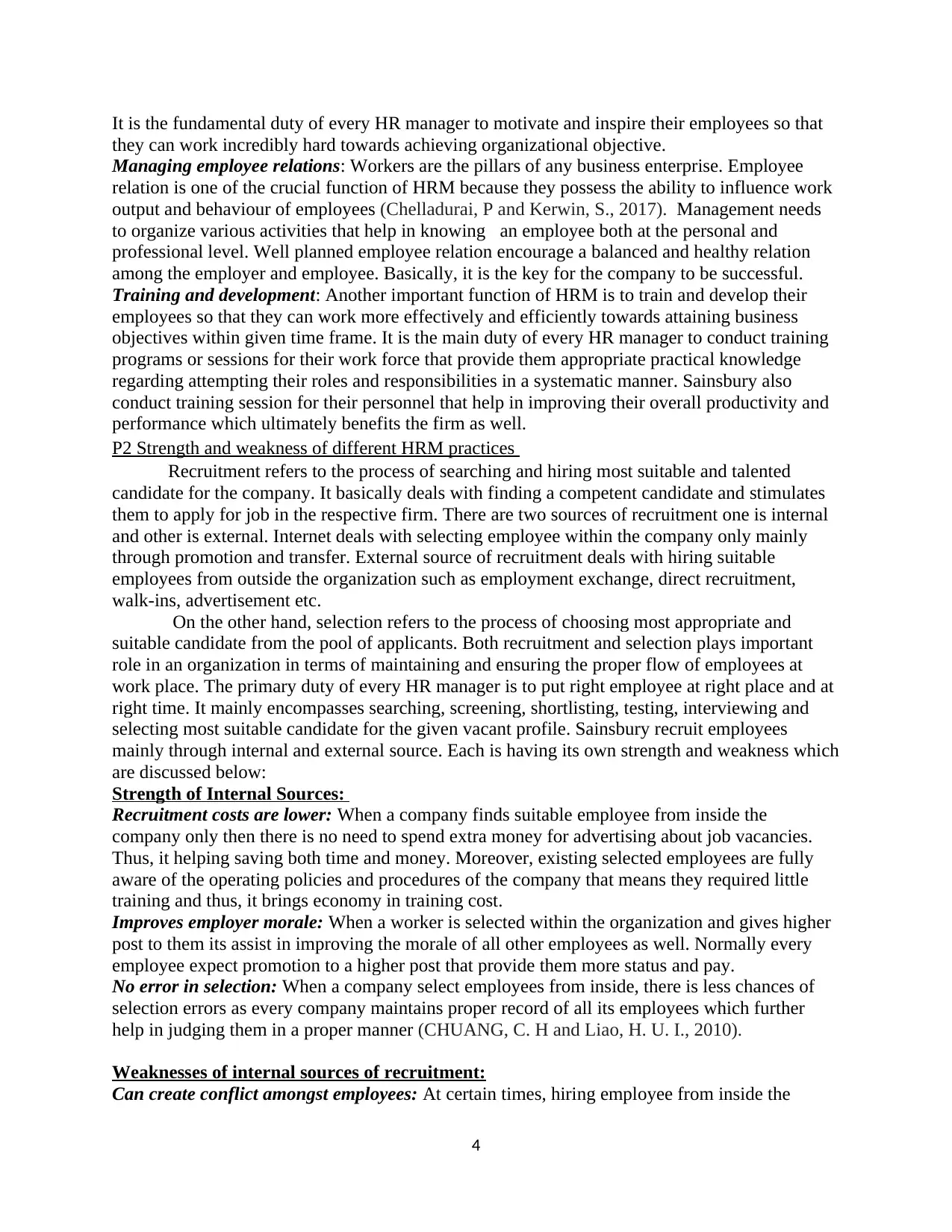
It is the fundamental duty of every HR manager to motivate and inspire their employees so that
they can work incredibly hard towards achieving organizational objective.
Managing employee relations: Workers are the pillars of any business enterprise. Employee
relation is one of the crucial function of HRM because they possess the ability to influence work
output and behaviour of employees (Chelladurai, P and Kerwin, S., 2017). Management needs
to organize various activities that help in knowing an employee both at the personal and
professional level. Well planned employee relation encourage a balanced and healthy relation
among the employer and employee. Basically, it is the key for the company to be successful.
Training and development: Another important function of HRM is to train and develop their
employees so that they can work more effectively and efficiently towards attaining business
objectives within given time frame. It is the main duty of every HR manager to conduct training
programs or sessions for their work force that provide them appropriate practical knowledge
regarding attempting their roles and responsibilities in a systematic manner. Sainsbury also
conduct training session for their personnel that help in improving their overall productivity and
performance which ultimately benefits the firm as well.
P2 Strength and weakness of different HRM practices
Recruitment refers to the process of searching and hiring most suitable and talented
candidate for the company. It basically deals with finding a competent candidate and stimulates
them to apply for job in the respective firm. There are two sources of recruitment one is internal
and other is external. Internet deals with selecting employee within the company only mainly
through promotion and transfer. External source of recruitment deals with hiring suitable
employees from outside the organization such as employment exchange, direct recruitment,
walk-ins, advertisement etc.
On the other hand, selection refers to the process of choosing most appropriate and
suitable candidate from the pool of applicants. Both recruitment and selection plays important
role in an organization in terms of maintaining and ensuring the proper flow of employees at
work place. The primary duty of every HR manager is to put right employee at right place and at
right time. It mainly encompasses searching, screening, shortlisting, testing, interviewing and
selecting most suitable candidate for the given vacant profile. Sainsbury recruit employees
mainly through internal and external source. Each is having its own strength and weakness which
are discussed below:
Strength of Internal Sources:
Recruitment costs are lower: When a company finds suitable employee from inside the
company only then there is no need to spend extra money for advertising about job vacancies.
Thus, it helping saving both time and money. Moreover, existing selected employees are fully
aware of the operating policies and procedures of the company that means they required little
training and thus, it brings economy in training cost.
Improves employer morale: When a worker is selected within the organization and gives higher
post to them its assist in improving the morale of all other employees as well. Normally every
employee expect promotion to a higher post that provide them more status and pay.
No error in selection: When a company select employees from inside, there is less chances of
selection errors as every company maintains proper record of all its employees which further
help in judging them in a proper manner (CHUANG, C. H and Liao, H. U. I., 2010).
Weaknesses of internal sources of recruitment:
Can create conflict amongst employees: At certain times, hiring employee from inside the
4
they can work incredibly hard towards achieving organizational objective.
Managing employee relations: Workers are the pillars of any business enterprise. Employee
relation is one of the crucial function of HRM because they possess the ability to influence work
output and behaviour of employees (Chelladurai, P and Kerwin, S., 2017). Management needs
to organize various activities that help in knowing an employee both at the personal and
professional level. Well planned employee relation encourage a balanced and healthy relation
among the employer and employee. Basically, it is the key for the company to be successful.
Training and development: Another important function of HRM is to train and develop their
employees so that they can work more effectively and efficiently towards attaining business
objectives within given time frame. It is the main duty of every HR manager to conduct training
programs or sessions for their work force that provide them appropriate practical knowledge
regarding attempting their roles and responsibilities in a systematic manner. Sainsbury also
conduct training session for their personnel that help in improving their overall productivity and
performance which ultimately benefits the firm as well.
P2 Strength and weakness of different HRM practices
Recruitment refers to the process of searching and hiring most suitable and talented
candidate for the company. It basically deals with finding a competent candidate and stimulates
them to apply for job in the respective firm. There are two sources of recruitment one is internal
and other is external. Internet deals with selecting employee within the company only mainly
through promotion and transfer. External source of recruitment deals with hiring suitable
employees from outside the organization such as employment exchange, direct recruitment,
walk-ins, advertisement etc.
On the other hand, selection refers to the process of choosing most appropriate and
suitable candidate from the pool of applicants. Both recruitment and selection plays important
role in an organization in terms of maintaining and ensuring the proper flow of employees at
work place. The primary duty of every HR manager is to put right employee at right place and at
right time. It mainly encompasses searching, screening, shortlisting, testing, interviewing and
selecting most suitable candidate for the given vacant profile. Sainsbury recruit employees
mainly through internal and external source. Each is having its own strength and weakness which
are discussed below:
Strength of Internal Sources:
Recruitment costs are lower: When a company finds suitable employee from inside the
company only then there is no need to spend extra money for advertising about job vacancies.
Thus, it helping saving both time and money. Moreover, existing selected employees are fully
aware of the operating policies and procedures of the company that means they required little
training and thus, it brings economy in training cost.
Improves employer morale: When a worker is selected within the organization and gives higher
post to them its assist in improving the morale of all other employees as well. Normally every
employee expect promotion to a higher post that provide them more status and pay.
No error in selection: When a company select employees from inside, there is less chances of
selection errors as every company maintains proper record of all its employees which further
help in judging them in a proper manner (CHUANG, C. H and Liao, H. U. I., 2010).
Weaknesses of internal sources of recruitment:
Can create conflict amongst employees: At certain times, hiring employee from inside the
4
Paraphrase This Document
Need a fresh take? Get an instant paraphrase of this document with our AI Paraphraser
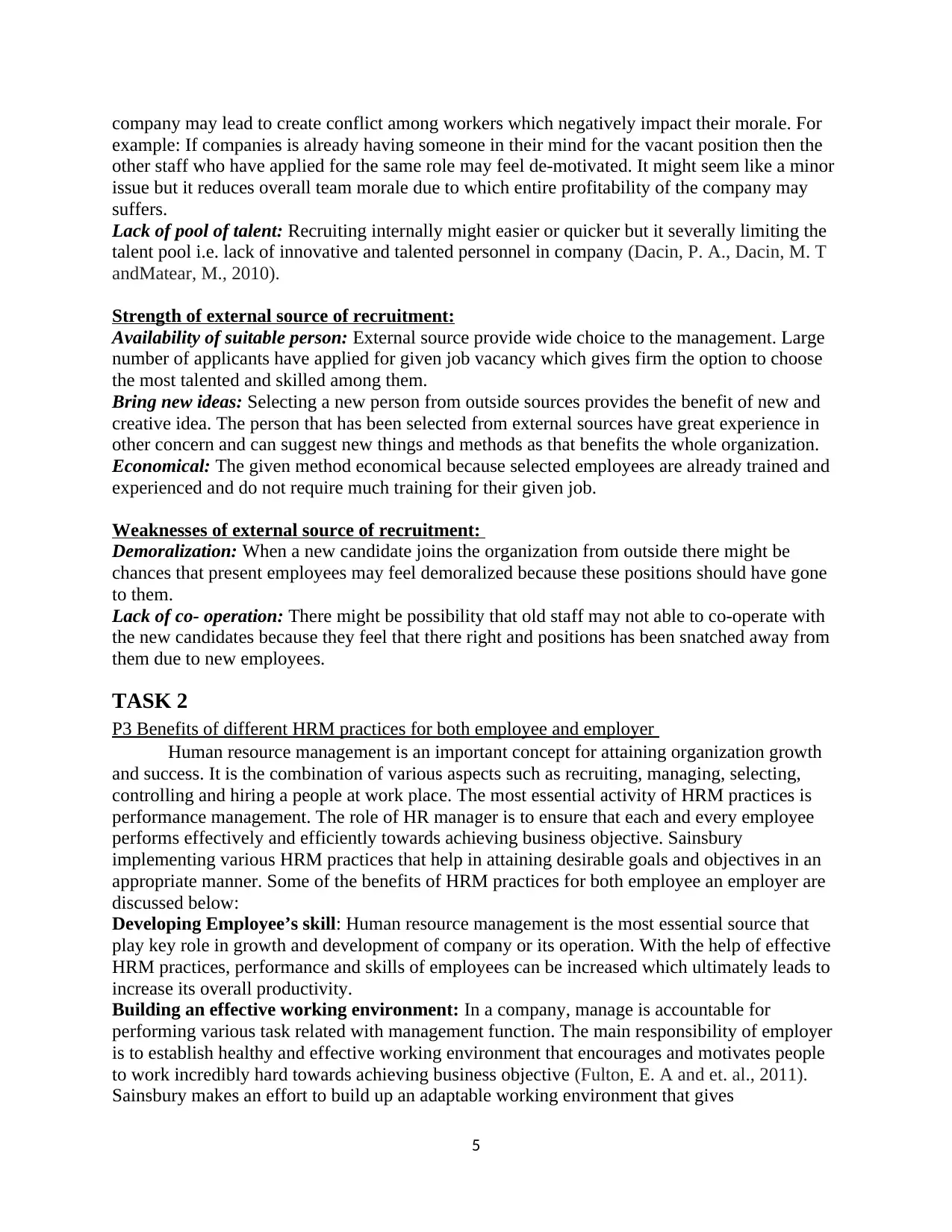
company may lead to create conflict among workers which negatively impact their morale. For
example: If companies is already having someone in their mind for the vacant position then the
other staff who have applied for the same role may feel de-motivated. It might seem like a minor
issue but it reduces overall team morale due to which entire profitability of the company may
suffers.
Lack of pool of talent: Recruiting internally might easier or quicker but it severally limiting the
talent pool i.e. lack of innovative and talented personnel in company (Dacin, P. A., Dacin, M. T
andMatear, M., 2010).
Strength of external source of recruitment:
Availability of suitable person: External source provide wide choice to the management. Large
number of applicants have applied for given job vacancy which gives firm the option to choose
the most talented and skilled among them.
Bring new ideas: Selecting a new person from outside sources provides the benefit of new and
creative idea. The person that has been selected from external sources have great experience in
other concern and can suggest new things and methods as that benefits the whole organization.
Economical: The given method economical because selected employees are already trained and
experienced and do not require much training for their given job.
Weaknesses of external source of recruitment:
Demoralization: When a new candidate joins the organization from outside there might be
chances that present employees may feel demoralized because these positions should have gone
to them.
Lack of co- operation: There might be possibility that old staff may not able to co-operate with
the new candidates because they feel that there right and positions has been snatched away from
them due to new employees.
TASK 2
P3 Benefits of different HRM practices for both employee and employer
Human resource management is an important concept for attaining organization growth
and success. It is the combination of various aspects such as recruiting, managing, selecting,
controlling and hiring a people at work place. The most essential activity of HRM practices is
performance management. The role of HR manager is to ensure that each and every employee
performs effectively and efficiently towards achieving business objective. Sainsbury
implementing various HRM practices that help in attaining desirable goals and objectives in an
appropriate manner. Some of the benefits of HRM practices for both employee an employer are
discussed below:
Developing Employee’s skill: Human resource management is the most essential source that
play key role in growth and development of company or its operation. With the help of effective
HRM practices, performance and skills of employees can be increased which ultimately leads to
increase its overall productivity.
Building an effective working environment: In a company, manage is accountable for
performing various task related with management function. The main responsibility of employer
is to establish healthy and effective working environment that encourages and motivates people
to work incredibly hard towards achieving business objective (Fulton, E. A and et. al., 2011).
Sainsbury makes an effort to build up an adaptable working environment that gives
5
example: If companies is already having someone in their mind for the vacant position then the
other staff who have applied for the same role may feel de-motivated. It might seem like a minor
issue but it reduces overall team morale due to which entire profitability of the company may
suffers.
Lack of pool of talent: Recruiting internally might easier or quicker but it severally limiting the
talent pool i.e. lack of innovative and talented personnel in company (Dacin, P. A., Dacin, M. T
andMatear, M., 2010).
Strength of external source of recruitment:
Availability of suitable person: External source provide wide choice to the management. Large
number of applicants have applied for given job vacancy which gives firm the option to choose
the most talented and skilled among them.
Bring new ideas: Selecting a new person from outside sources provides the benefit of new and
creative idea. The person that has been selected from external sources have great experience in
other concern and can suggest new things and methods as that benefits the whole organization.
Economical: The given method economical because selected employees are already trained and
experienced and do not require much training for their given job.
Weaknesses of external source of recruitment:
Demoralization: When a new candidate joins the organization from outside there might be
chances that present employees may feel demoralized because these positions should have gone
to them.
Lack of co- operation: There might be possibility that old staff may not able to co-operate with
the new candidates because they feel that there right and positions has been snatched away from
them due to new employees.
TASK 2
P3 Benefits of different HRM practices for both employee and employer
Human resource management is an important concept for attaining organization growth
and success. It is the combination of various aspects such as recruiting, managing, selecting,
controlling and hiring a people at work place. The most essential activity of HRM practices is
performance management. The role of HR manager is to ensure that each and every employee
performs effectively and efficiently towards achieving business objective. Sainsbury
implementing various HRM practices that help in attaining desirable goals and objectives in an
appropriate manner. Some of the benefits of HRM practices for both employee an employer are
discussed below:
Developing Employee’s skill: Human resource management is the most essential source that
play key role in growth and development of company or its operation. With the help of effective
HRM practices, performance and skills of employees can be increased which ultimately leads to
increase its overall productivity.
Building an effective working environment: In a company, manage is accountable for
performing various task related with management function. The main responsibility of employer
is to establish healthy and effective working environment that encourages and motivates people
to work incredibly hard towards achieving business objective (Fulton, E. A and et. al., 2011).
Sainsbury makes an effort to build up an adaptable working environment that gives
5
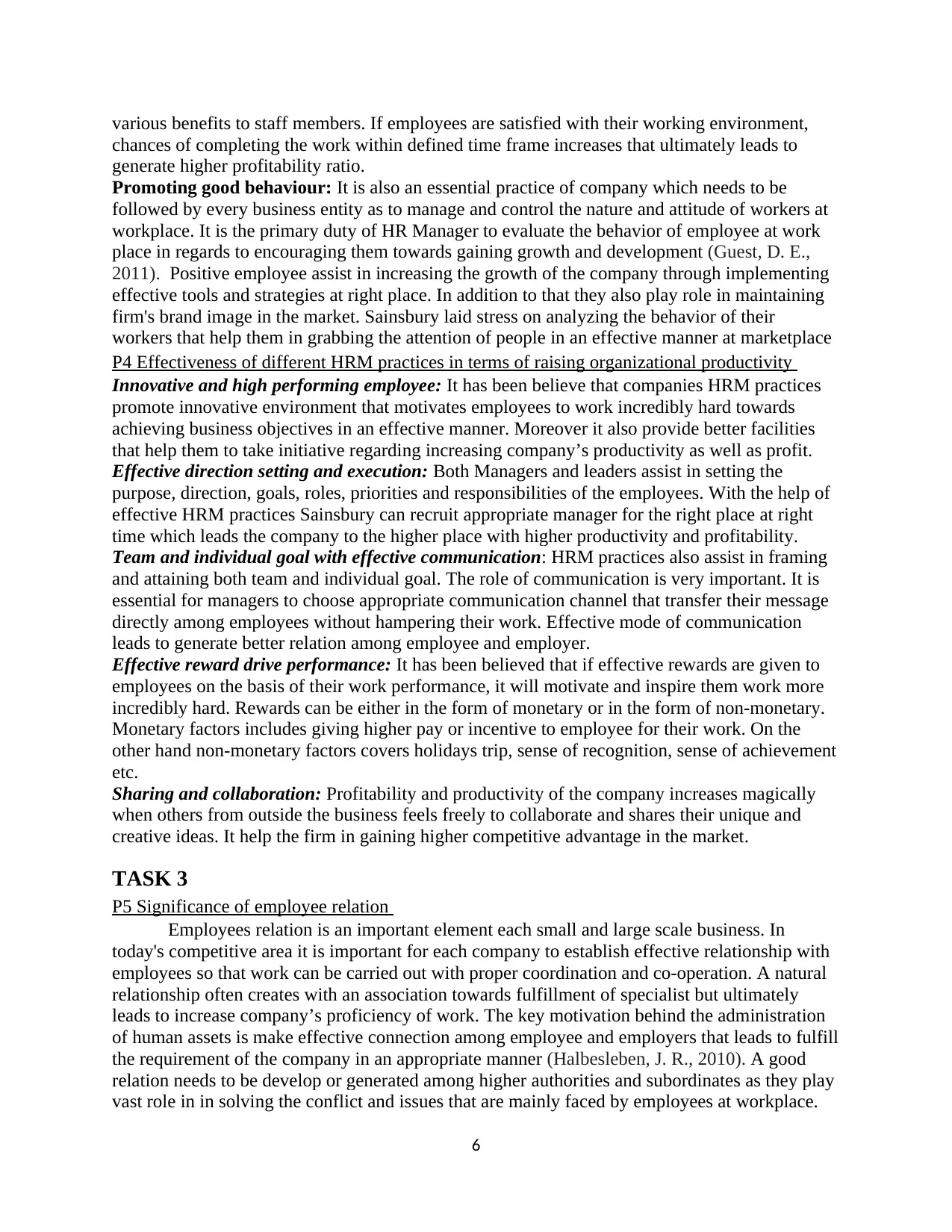
various benefits to staff members. If employees are satisfied with their working environment,
chances of completing the work within defined time frame increases that ultimately leads to
generate higher profitability ratio.
Promoting good behaviour: It is also an essential practice of company which needs to be
followed by every business entity as to manage and control the nature and attitude of workers at
workplace. It is the primary duty of HR Manager to evaluate the behavior of employee at work
place in regards to encouraging them towards gaining growth and development (Guest, D. E.,
2011). Positive employee assist in increasing the growth of the company through implementing
effective tools and strategies at right place. In addition to that they also play role in maintaining
firm's brand image in the market. Sainsbury laid stress on analyzing the behavior of their
workers that help them in grabbing the attention of people in an effective manner at marketplace
P4 Effectiveness of different HRM practices in terms of raising organizational productivity
Innovative and high performing employee: It has been believe that companies HRM practices
promote innovative environment that motivates employees to work incredibly hard towards
achieving business objectives in an effective manner. Moreover it also provide better facilities
that help them to take initiative regarding increasing company’s productivity as well as profit.
Effective direction setting and execution: Both Managers and leaders assist in setting the
purpose, direction, goals, roles, priorities and responsibilities of the employees. With the help of
effective HRM practices Sainsbury can recruit appropriate manager for the right place at right
time which leads the company to the higher place with higher productivity and profitability.
Team and individual goal with effective communication: HRM practices also assist in framing
and attaining both team and individual goal. The role of communication is very important. It is
essential for managers to choose appropriate communication channel that transfer their message
directly among employees without hampering their work. Effective mode of communication
leads to generate better relation among employee and employer.
Effective reward drive performance: It has been believed that if effective rewards are given to
employees on the basis of their work performance, it will motivate and inspire them work more
incredibly hard. Rewards can be either in the form of monetary or in the form of non-monetary.
Monetary factors includes giving higher pay or incentive to employee for their work. On the
other hand non-monetary factors covers holidays trip, sense of recognition, sense of achievement
etc.
Sharing and collaboration: Profitability and productivity of the company increases magically
when others from outside the business feels freely to collaborate and shares their unique and
creative ideas. It help the firm in gaining higher competitive advantage in the market.
TASK 3
P5 Significance of employee relation
Employees relation is an important element each small and large scale business. In
today's competitive area it is important for each company to establish effective relationship with
employees so that work can be carried out with proper coordination and co-operation. A natural
relationship often creates with an association towards fulfillment of specialist but ultimately
leads to increase company’s proficiency of work. The key motivation behind the administration
of human assets is make effective connection among employee and employers that leads to fulfill
the requirement of the company in an appropriate manner (Halbesleben, J. R., 2010). A good
relation needs to be develop or generated among higher authorities and subordinates as they play
vast role in in solving the conflict and issues that are mainly faced by employees at workplace.
6
chances of completing the work within defined time frame increases that ultimately leads to
generate higher profitability ratio.
Promoting good behaviour: It is also an essential practice of company which needs to be
followed by every business entity as to manage and control the nature and attitude of workers at
workplace. It is the primary duty of HR Manager to evaluate the behavior of employee at work
place in regards to encouraging them towards gaining growth and development (Guest, D. E.,
2011). Positive employee assist in increasing the growth of the company through implementing
effective tools and strategies at right place. In addition to that they also play role in maintaining
firm's brand image in the market. Sainsbury laid stress on analyzing the behavior of their
workers that help them in grabbing the attention of people in an effective manner at marketplace
P4 Effectiveness of different HRM practices in terms of raising organizational productivity
Innovative and high performing employee: It has been believe that companies HRM practices
promote innovative environment that motivates employees to work incredibly hard towards
achieving business objectives in an effective manner. Moreover it also provide better facilities
that help them to take initiative regarding increasing company’s productivity as well as profit.
Effective direction setting and execution: Both Managers and leaders assist in setting the
purpose, direction, goals, roles, priorities and responsibilities of the employees. With the help of
effective HRM practices Sainsbury can recruit appropriate manager for the right place at right
time which leads the company to the higher place with higher productivity and profitability.
Team and individual goal with effective communication: HRM practices also assist in framing
and attaining both team and individual goal. The role of communication is very important. It is
essential for managers to choose appropriate communication channel that transfer their message
directly among employees without hampering their work. Effective mode of communication
leads to generate better relation among employee and employer.
Effective reward drive performance: It has been believed that if effective rewards are given to
employees on the basis of their work performance, it will motivate and inspire them work more
incredibly hard. Rewards can be either in the form of monetary or in the form of non-monetary.
Monetary factors includes giving higher pay or incentive to employee for their work. On the
other hand non-monetary factors covers holidays trip, sense of recognition, sense of achievement
etc.
Sharing and collaboration: Profitability and productivity of the company increases magically
when others from outside the business feels freely to collaborate and shares their unique and
creative ideas. It help the firm in gaining higher competitive advantage in the market.
TASK 3
P5 Significance of employee relation
Employees relation is an important element each small and large scale business. In
today's competitive area it is important for each company to establish effective relationship with
employees so that work can be carried out with proper coordination and co-operation. A natural
relationship often creates with an association towards fulfillment of specialist but ultimately
leads to increase company’s proficiency of work. The key motivation behind the administration
of human assets is make effective connection among employee and employers that leads to fulfill
the requirement of the company in an appropriate manner (Halbesleben, J. R., 2010). A good
relation needs to be develop or generated among higher authorities and subordinates as they play
vast role in in solving the conflict and issues that are mainly faced by employees at workplace.
6
⊘ This is a preview!⊘
Do you want full access?
Subscribe today to unlock all pages.

Trusted by 1+ million students worldwide
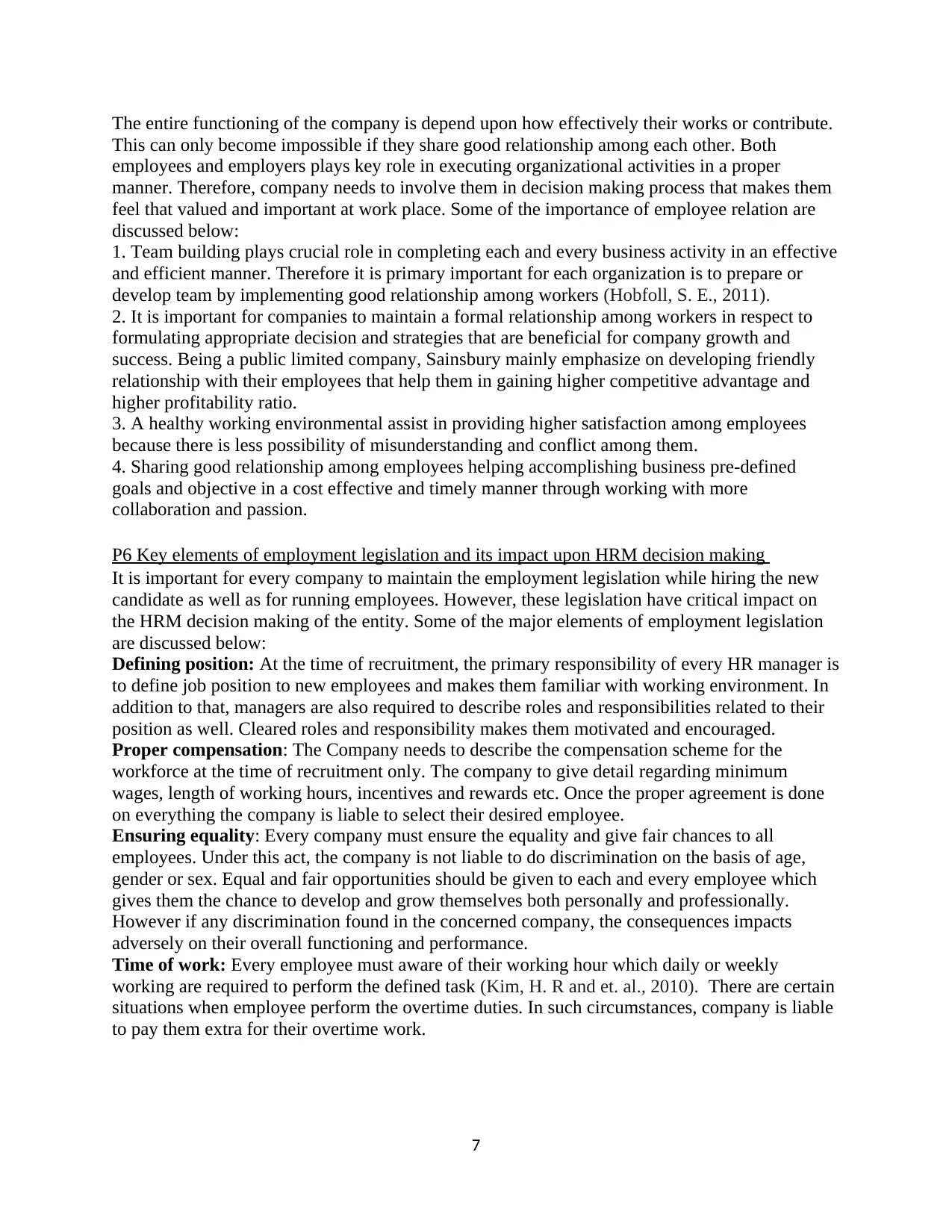
The entire functioning of the company is depend upon how effectively their works or contribute.
This can only become impossible if they share good relationship among each other. Both
employees and employers plays key role in executing organizational activities in a proper
manner. Therefore, company needs to involve them in decision making process that makes them
feel that valued and important at work place. Some of the importance of employee relation are
discussed below:
1. Team building plays crucial role in completing each and every business activity in an effective
and efficient manner. Therefore it is primary important for each organization is to prepare or
develop team by implementing good relationship among workers (Hobfoll, S. E., 2011).
2. It is important for companies to maintain a formal relationship among workers in respect to
formulating appropriate decision and strategies that are beneficial for company growth and
success. Being a public limited company, Sainsbury mainly emphasize on developing friendly
relationship with their employees that help them in gaining higher competitive advantage and
higher profitability ratio.
3. A healthy working environmental assist in providing higher satisfaction among employees
because there is less possibility of misunderstanding and conflict among them.
4. Sharing good relationship among employees helping accomplishing business pre-defined
goals and objective in a cost effective and timely manner through working with more
collaboration and passion.
P6 Key elements of employment legislation and its impact upon HRM decision making
It is important for every company to maintain the employment legislation while hiring the new
candidate as well as for running employees. However, these legislation have critical impact on
the HRM decision making of the entity. Some of the major elements of employment legislation
are discussed below:
Defining position: At the time of recruitment, the primary responsibility of every HR manager is
to define job position to new employees and makes them familiar with working environment. In
addition to that, managers are also required to describe roles and responsibilities related to their
position as well. Cleared roles and responsibility makes them motivated and encouraged.
Proper compensation: The Company needs to describe the compensation scheme for the
workforce at the time of recruitment only. The company to give detail regarding minimum
wages, length of working hours, incentives and rewards etc. Once the proper agreement is done
on everything the company is liable to select their desired employee.
Ensuring equality: Every company must ensure the equality and give fair chances to all
employees. Under this act, the company is not liable to do discrimination on the basis of age,
gender or sex. Equal and fair opportunities should be given to each and every employee which
gives them the chance to develop and grow themselves both personally and professionally.
However if any discrimination found in the concerned company, the consequences impacts
adversely on their overall functioning and performance.
Time of work: Every employee must aware of their working hour which daily or weekly
working are required to perform the defined task (Kim, H. R and et. al., 2010). There are certain
situations when employee perform the overtime duties. In such circumstances, company is liable
to pay them extra for their overtime work.
7
This can only become impossible if they share good relationship among each other. Both
employees and employers plays key role in executing organizational activities in a proper
manner. Therefore, company needs to involve them in decision making process that makes them
feel that valued and important at work place. Some of the importance of employee relation are
discussed below:
1. Team building plays crucial role in completing each and every business activity in an effective
and efficient manner. Therefore it is primary important for each organization is to prepare or
develop team by implementing good relationship among workers (Hobfoll, S. E., 2011).
2. It is important for companies to maintain a formal relationship among workers in respect to
formulating appropriate decision and strategies that are beneficial for company growth and
success. Being a public limited company, Sainsbury mainly emphasize on developing friendly
relationship with their employees that help them in gaining higher competitive advantage and
higher profitability ratio.
3. A healthy working environmental assist in providing higher satisfaction among employees
because there is less possibility of misunderstanding and conflict among them.
4. Sharing good relationship among employees helping accomplishing business pre-defined
goals and objective in a cost effective and timely manner through working with more
collaboration and passion.
P6 Key elements of employment legislation and its impact upon HRM decision making
It is important for every company to maintain the employment legislation while hiring the new
candidate as well as for running employees. However, these legislation have critical impact on
the HRM decision making of the entity. Some of the major elements of employment legislation
are discussed below:
Defining position: At the time of recruitment, the primary responsibility of every HR manager is
to define job position to new employees and makes them familiar with working environment. In
addition to that, managers are also required to describe roles and responsibilities related to their
position as well. Cleared roles and responsibility makes them motivated and encouraged.
Proper compensation: The Company needs to describe the compensation scheme for the
workforce at the time of recruitment only. The company to give detail regarding minimum
wages, length of working hours, incentives and rewards etc. Once the proper agreement is done
on everything the company is liable to select their desired employee.
Ensuring equality: Every company must ensure the equality and give fair chances to all
employees. Under this act, the company is not liable to do discrimination on the basis of age,
gender or sex. Equal and fair opportunities should be given to each and every employee which
gives them the chance to develop and grow themselves both personally and professionally.
However if any discrimination found in the concerned company, the consequences impacts
adversely on their overall functioning and performance.
Time of work: Every employee must aware of their working hour which daily or weekly
working are required to perform the defined task (Kim, H. R and et. al., 2010). There are certain
situations when employee perform the overtime duties. In such circumstances, company is liable
to pay them extra for their overtime work.
7
Paraphrase This Document
Need a fresh take? Get an instant paraphrase of this document with our AI Paraphraser
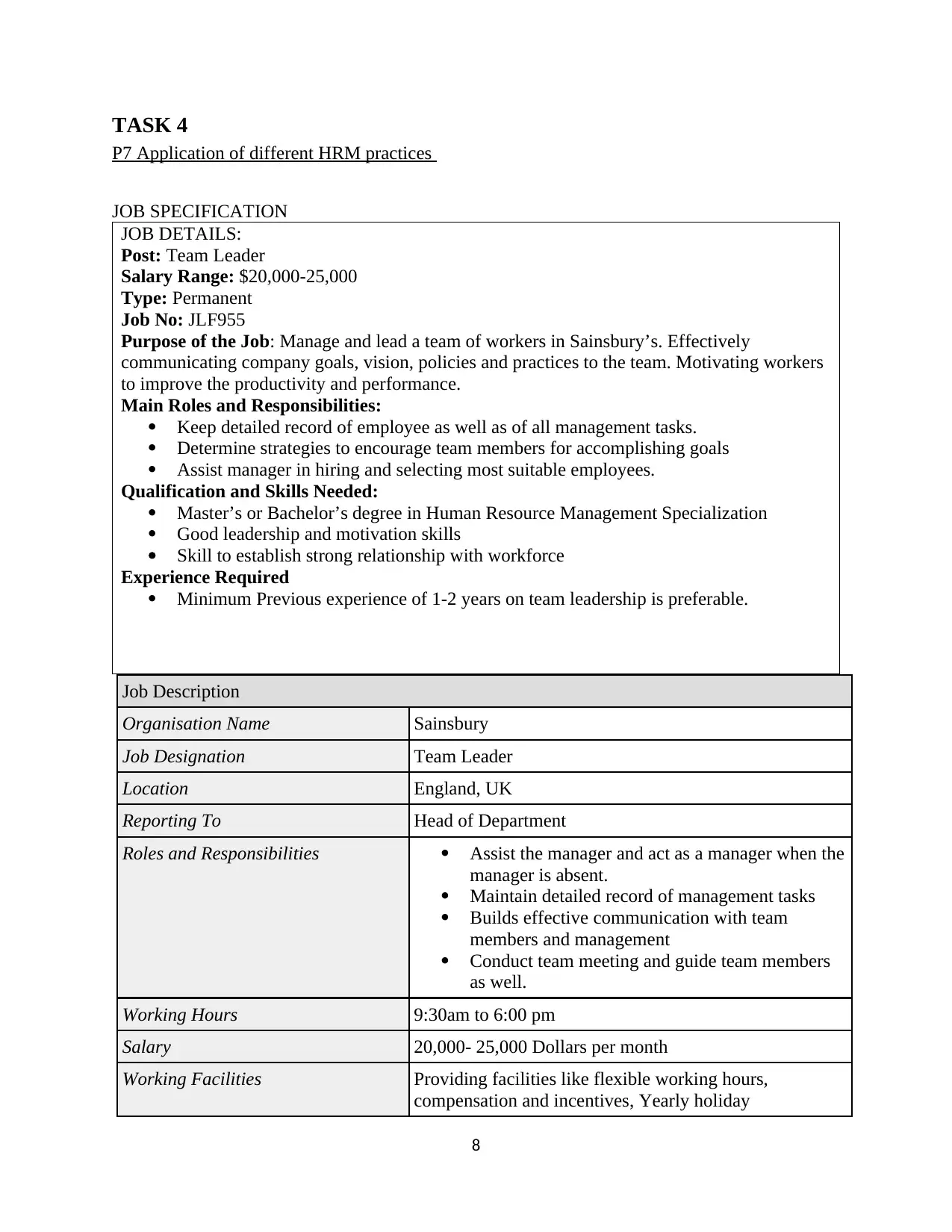
TASK 4
P7 Application of different HRM practices
JOB SPECIFICATION
JOB DETAILS:
Post: Team Leader
Salary Range: $20,000-25,000
Type: Permanent
Job No: JLF955
Purpose of the Job: Manage and lead a team of workers in Sainsbury’s. Effectively
communicating company goals, vision, policies and practices to the team. Motivating workers
to improve the productivity and performance.
Main Roles and Responsibilities:
Keep detailed record of employee as well as of all management tasks.
Determine strategies to encourage team members for accomplishing goals
Assist manager in hiring and selecting most suitable employees.
Qualification and Skills Needed:
Master’s or Bachelor’s degree in Human Resource Management Specialization
Good leadership and motivation skills
Skill to establish strong relationship with workforce
Experience Required
Minimum Previous experience of 1-2 years on team leadership is preferable.
Job Description
Organisation Name Sainsbury
Job Designation Team Leader
Location England, UK
Reporting To Head of Department
Roles and Responsibilities Assist the manager and act as a manager when the
manager is absent.
Maintain detailed record of management tasks
Builds effective communication with team
members and management
Conduct team meeting and guide team members
as well.
Working Hours 9:30am to 6:00 pm
Salary 20,000- 25,000 Dollars per month
Working Facilities Providing facilities like flexible working hours,
compensation and incentives, Yearly holiday
8
P7 Application of different HRM practices
JOB SPECIFICATION
JOB DETAILS:
Post: Team Leader
Salary Range: $20,000-25,000
Type: Permanent
Job No: JLF955
Purpose of the Job: Manage and lead a team of workers in Sainsbury’s. Effectively
communicating company goals, vision, policies and practices to the team. Motivating workers
to improve the productivity and performance.
Main Roles and Responsibilities:
Keep detailed record of employee as well as of all management tasks.
Determine strategies to encourage team members for accomplishing goals
Assist manager in hiring and selecting most suitable employees.
Qualification and Skills Needed:
Master’s or Bachelor’s degree in Human Resource Management Specialization
Good leadership and motivation skills
Skill to establish strong relationship with workforce
Experience Required
Minimum Previous experience of 1-2 years on team leadership is preferable.
Job Description
Organisation Name Sainsbury
Job Designation Team Leader
Location England, UK
Reporting To Head of Department
Roles and Responsibilities Assist the manager and act as a manager when the
manager is absent.
Maintain detailed record of management tasks
Builds effective communication with team
members and management
Conduct team meeting and guide team members
as well.
Working Hours 9:30am to 6:00 pm
Salary 20,000- 25,000 Dollars per month
Working Facilities Providing facilities like flexible working hours,
compensation and incentives, Yearly holiday
8
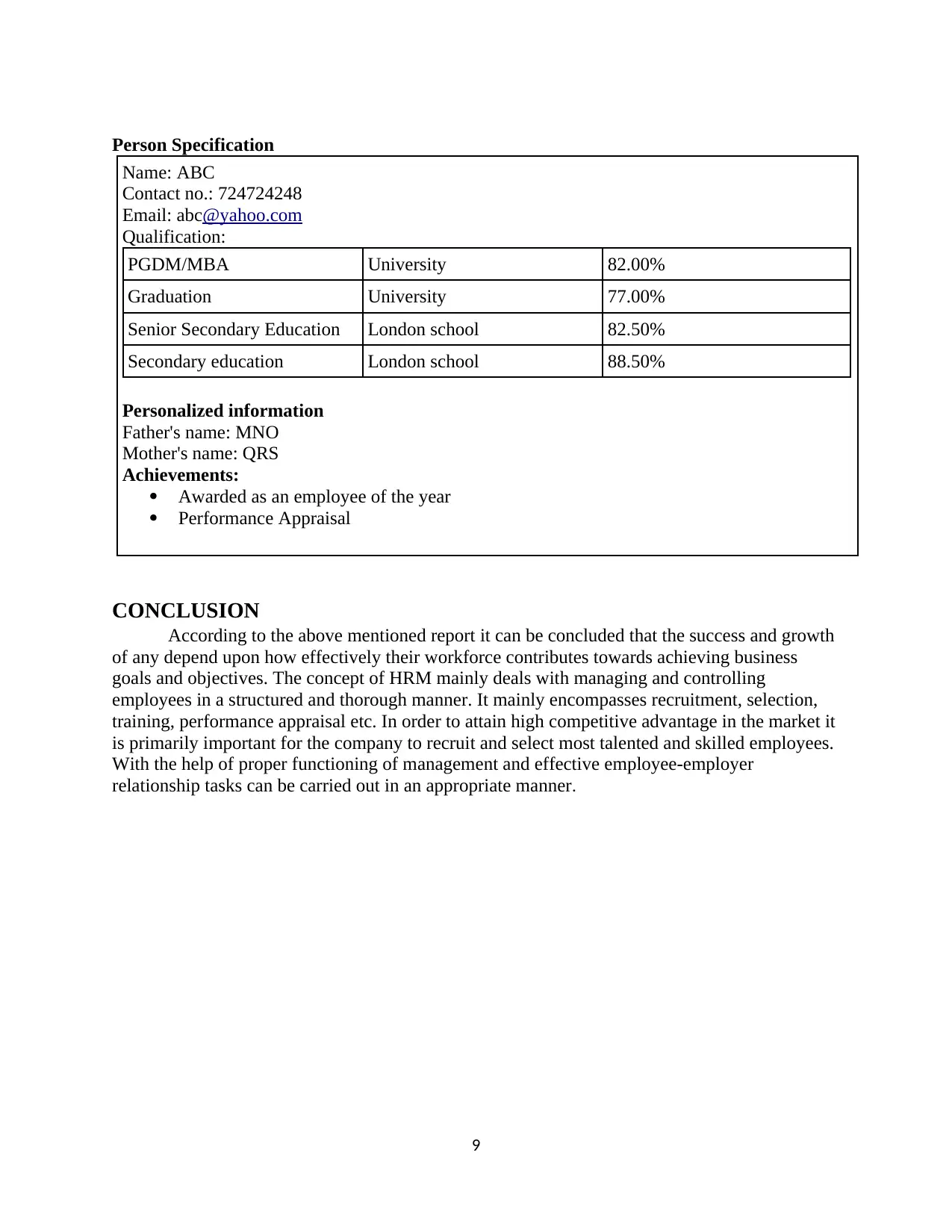
Person Specification
Name: ABC
Contact no.: 724724248
Email: abc@yahoo.com
Qualification:
PGDM/MBA University 82.00%
Graduation University 77.00%
Senior Secondary Education London school 82.50%
Secondary education London school 88.50%
Personalized information
Father's name: MNO
Mother's name: QRS
Achievements:
Awarded as an employee of the year
Performance Appraisal
CONCLUSION
According to the above mentioned report it can be concluded that the success and growth
of any depend upon how effectively their workforce contributes towards achieving business
goals and objectives. The concept of HRM mainly deals with managing and controlling
employees in a structured and thorough manner. It mainly encompasses recruitment, selection,
training, performance appraisal etc. In order to attain high competitive advantage in the market it
is primarily important for the company to recruit and select most talented and skilled employees.
With the help of proper functioning of management and effective employee-employer
relationship tasks can be carried out in an appropriate manner.
9
Name: ABC
Contact no.: 724724248
Email: abc@yahoo.com
Qualification:
PGDM/MBA University 82.00%
Graduation University 77.00%
Senior Secondary Education London school 82.50%
Secondary education London school 88.50%
Personalized information
Father's name: MNO
Mother's name: QRS
Achievements:
Awarded as an employee of the year
Performance Appraisal
CONCLUSION
According to the above mentioned report it can be concluded that the success and growth
of any depend upon how effectively their workforce contributes towards achieving business
goals and objectives. The concept of HRM mainly deals with managing and controlling
employees in a structured and thorough manner. It mainly encompasses recruitment, selection,
training, performance appraisal etc. In order to attain high competitive advantage in the market it
is primarily important for the company to recruit and select most talented and skilled employees.
With the help of proper functioning of management and effective employee-employer
relationship tasks can be carried out in an appropriate manner.
9
⊘ This is a preview!⊘
Do you want full access?
Subscribe today to unlock all pages.

Trusted by 1+ million students worldwide
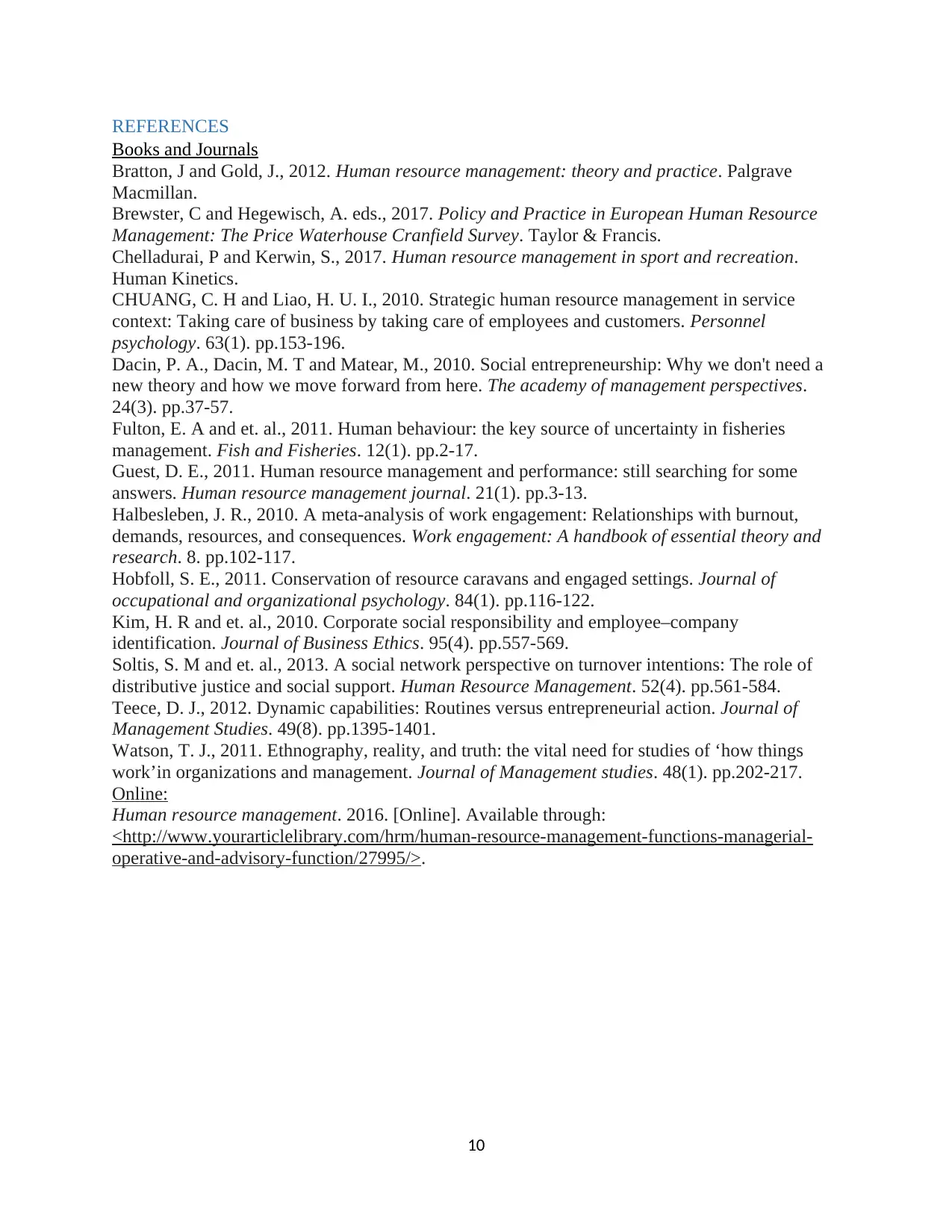
REFERENCES
Books and Journals
Bratton, J and Gold, J., 2012. Human resource management: theory and practice. Palgrave
Macmillan.
Brewster, C and Hegewisch, A. eds., 2017. Policy and Practice in European Human Resource
Management: The Price Waterhouse Cranfield Survey. Taylor & Francis.
Chelladurai, P and Kerwin, S., 2017. Human resource management in sport and recreation.
Human Kinetics.
CHUANG, C. H and Liao, H. U. I., 2010. Strategic human resource management in service
context: Taking care of business by taking care of employees and customers. Personnel
psychology. 63(1). pp.153-196.
Dacin, P. A., Dacin, M. T and Matear, M., 2010. Social entrepreneurship: Why we don't need a
new theory and how we move forward from here. The academy of management perspectives.
24(3). pp.37-57.
Fulton, E. A and et. al., 2011. Human behaviour: the key source of uncertainty in fisheries
management. Fish and Fisheries. 12(1). pp.2-17.
Guest, D. E., 2011. Human resource management and performance: still searching for some
answers. Human resource management journal. 21(1). pp.3-13.
Halbesleben, J. R., 2010. A meta-analysis of work engagement: Relationships with burnout,
demands, resources, and consequences. Work engagement: A handbook of essential theory and
research. 8. pp.102-117.
Hobfoll, S. E., 2011. Conservation of resource caravans and engaged settings. Journal of
occupational and organizational psychology. 84(1). pp.116-122.
Kim, H. R and et. al., 2010. Corporate social responsibility and employee–company
identification. Journal of Business Ethics. 95(4). pp.557-569.
Soltis, S. M and et. al., 2013. A social network perspective on turnover intentions: The role of
distributive justice and social support. Human Resource Management. 52(4). pp.561-584.
Teece, D. J., 2012. Dynamic capabilities: Routines versus entrepreneurial action. Journal of
Management Studies. 49(8). pp.1395-1401.
Watson, T. J., 2011. Ethnography, reality, and truth: the vital need for studies of ‘how things
work’in organizations and management. Journal of Management studies. 48(1). pp.202-217.
Online:
Human resource management. 2016. [Online]. Available through:
<http://www.yourarticlelibrary.com/hrm/human-resource-management-functions-managerial-
operative-and-advisory-function/27995/>.
10
Books and Journals
Bratton, J and Gold, J., 2012. Human resource management: theory and practice. Palgrave
Macmillan.
Brewster, C and Hegewisch, A. eds., 2017. Policy and Practice in European Human Resource
Management: The Price Waterhouse Cranfield Survey. Taylor & Francis.
Chelladurai, P and Kerwin, S., 2017. Human resource management in sport and recreation.
Human Kinetics.
CHUANG, C. H and Liao, H. U. I., 2010. Strategic human resource management in service
context: Taking care of business by taking care of employees and customers. Personnel
psychology. 63(1). pp.153-196.
Dacin, P. A., Dacin, M. T and Matear, M., 2010. Social entrepreneurship: Why we don't need a
new theory and how we move forward from here. The academy of management perspectives.
24(3). pp.37-57.
Fulton, E. A and et. al., 2011. Human behaviour: the key source of uncertainty in fisheries
management. Fish and Fisheries. 12(1). pp.2-17.
Guest, D. E., 2011. Human resource management and performance: still searching for some
answers. Human resource management journal. 21(1). pp.3-13.
Halbesleben, J. R., 2010. A meta-analysis of work engagement: Relationships with burnout,
demands, resources, and consequences. Work engagement: A handbook of essential theory and
research. 8. pp.102-117.
Hobfoll, S. E., 2011. Conservation of resource caravans and engaged settings. Journal of
occupational and organizational psychology. 84(1). pp.116-122.
Kim, H. R and et. al., 2010. Corporate social responsibility and employee–company
identification. Journal of Business Ethics. 95(4). pp.557-569.
Soltis, S. M and et. al., 2013. A social network perspective on turnover intentions: The role of
distributive justice and social support. Human Resource Management. 52(4). pp.561-584.
Teece, D. J., 2012. Dynamic capabilities: Routines versus entrepreneurial action. Journal of
Management Studies. 49(8). pp.1395-1401.
Watson, T. J., 2011. Ethnography, reality, and truth: the vital need for studies of ‘how things
work’in organizations and management. Journal of Management studies. 48(1). pp.202-217.
Online:
Human resource management. 2016. [Online]. Available through:
<http://www.yourarticlelibrary.com/hrm/human-resource-management-functions-managerial-
operative-and-advisory-function/27995/>.
10
1 out of 10
Related Documents
Your All-in-One AI-Powered Toolkit for Academic Success.
+13062052269
info@desklib.com
Available 24*7 on WhatsApp / Email
![[object Object]](/_next/static/media/star-bottom.7253800d.svg)
Unlock your academic potential
Copyright © 2020–2025 A2Z Services. All Rights Reserved. Developed and managed by ZUCOL.





